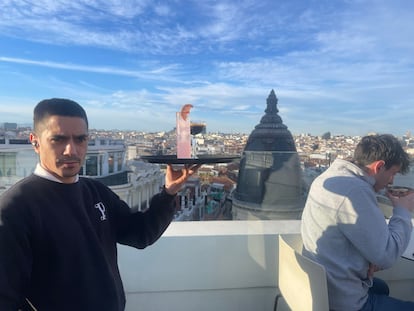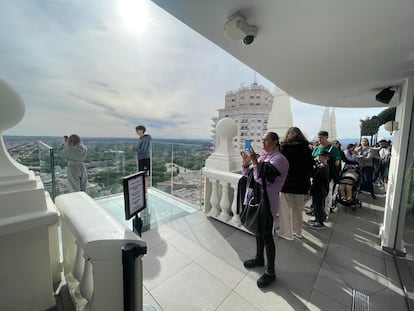Walking along Madrid’s Gran Vía looking at the sky offers the privilege of discovering a world to which few have access: the most sought-after rooftops in the capital. From the street, at the height of the Metrópolis building, you can see people the size of ants spending the afternoon clinging to the windows of the Círculo de Bellas Artes rooftop while taking photos and having a drink. They do it bathed in the evening light. “Can it go up?” two foreigners ask themselves, tempted to discover what it feels like to have Madrid at their feet.
For those who prefer to walk looking at the asphalt, there are also signs that something is happening up high: eternal queues in front of the doors of prestigious hotels and ground-level advertising signs offering views with cocktails on the top floor of the building. To access these oases, as they are often advertised, you need to pay, wait in a huge line, take eternal elevators and, in some cases, climb a few flights of stairs. Everything, to discover the secrets that these places keep. On these rooftops, take a gin tonic It can be up to twice as expensive as doing it, for example, on a terrace in the central Plaza de Santo Domingo, a few meters from the Emperador Hotel, where the cheapest drink is 15 euros.
The secret of these businesses is that they do not sell alcohol with sunsets, but rather an experience. And there everything goes. “People want to be like [la influencer] Dulceida, it is an aspirational question,” explains David Filgueira, director of Abica Gran Vía, which is advertised as the most port-like of the rooftops on this artery of Madrid.
El PAÍS has been documenting this phenomenon for five years. In this time, the number of rooftop terraces overlooking Gran Vía have increased by no less than 50%. They all boast one of the best views of the city. Specifically, in the first route that this newspaper did in 2019 there were 18 rooftops. From Plaza España to the Palacio de Cibeles, on Gran Vía, there are now 28, a fact that speaks of the concentration that is taking place on this very important street in the city. Everyone wants to reign in it.
There are no popular prices near the sky of Madrid. In fact, the gin tonic standard costs on the rooftops with views of Gran Vía 25% more than in 2019, when the first route was made through this important axis of the city to take note of the offer of this popular drink. Since then, this newspaper has made an annual review of the evolution of prices, something that gives an idea of the inflation experienced by the most select leisure plans in the city. According to him gin and tonic index 2019, the average price has gone from 11.94 euros to 14.94 euros if you opt for the gin and tonics cheaper on the menu, like Beefeater, Tanqueray or Larios. The client premium pays on average 17.60 for brands like Monkey 47 or Hendrick’s.

The Emperor’s commercial director, Pilar Lancha, has witnessed the evolution that the rooftops of Gran Vía have experienced in the last five years. “Now the entrance to hotels has been democratized to enjoy their spaces,” says Lancha, who hopes that the roof of her establishment will be the place to be or the fashionable place this summer. “We are the best place to have a gin tonic while enjoying a sunset over Gran Vía.” However, the sky of Madrid is not affordable for everyone.
The law of supply and demand works in the sky of Madrid. The more people want to enjoy them, the more rooftops open, and, as they are still not able to absorb all the demand that exists, prices continue to rise more and more without, for the moment, the influx being affected. The last one to open its doors was the rooftop Chicote Heavena terrace located on the tenth floor of the Montera hotel where the gin tonic It costs 20 euros and the entrance fee is 10. “We have the highest standards, we are not just another rooftop terrace,” says its communications director, Raúl Carmona.
Everyone agrees that the rooftops in the capital are experiencing a boom. “Madrid increasingly offers more possibilities from its heights. Furthermore, they are spaces that are currently no longer linked to the summer months or good temperatures, but any time of the year is good to enjoy these places,” says the spokesperson for the Santo Domingo Terrace.

As a result, most of them are open all year round. This is contributed to by the fact that the average temperature of the provincial capitals has risen practically one degree in recent years. “The weather has helped us a lot,” says the general manager of Ginkgo Restaurant & Sky Bar, Francisco García De Oro, who points out that, beyond global warming, the real driving force behind rooftops has been social networks. “They have been important for people to see our exclusive and prestigious spaces and say: ‘I want to be there too.’
García De Oro is clear about one thing: Madrid and its cocktails are booming. “We have 3,000 visitors a week and sell more than 1,800 cocktails during that period.” These types of places are not interested in a customer who only comes up to take a photo, so they have found that the best way to create that filter is to charge admission. “For us, the RIU is not competition, they are like the Empire State of New York,” he says.
At the RIU The price of admission is independent of the price of the drink. It only costs 10 euros to go up after 5:00 p.m., and the gin tonic cheaper is 10 euros. At the entrance to the rooftop, among rivers of queue, there is a woman who asks customers if
they are going to walk around first to see the 360 views, if they are going to wait in line to take photos on the glass walkway or if they go to want a table. “First the line, then the obligatory photo for Instagram and then, if we have time, we sit down to have a drink,” Isabel Martínez tells her partner, nervous about missing the golden hour while they wait in line for their turn for the photo. At the RIU the language that is least heard is Spanish.

Although each one tries to preserve its personality, the reality is that many of them belong to the same hotel groups. Without a doubt, the kings and those who started the business 10 years ago are Azotea Grupo, who opened the Circle of Fine Arts and Lizardpecker and, a couple of months ago, they obtained the concession of the roof of the Cibeles Palace. He gin tonic standard has gone from costing 17 euros to 14. José Manuel García, CEO and founder of Azotea Grupo, affirms that they were visionaries. “Throughout all these years, we have been positioning ourselves, I think, as number one. Some have evolved well and others have evolved worse, but it is very clear that right now Madrid’s Gran Vía is the nerve center for rooftops nationwide.”
SmartRental Group agrees with García. They also have three spaces with views of Gran Vía and are aware that “the public, more and more, is opting to change conventional terraces for rooftops,” according to the director of Beverage, José Manuel Sánchez.
In Hyatt hotel entrance, under the sculpture of Diana the Huntress, a mother and her daughter argue about whether to enter or not. “We have searched on Google for the top rooftop terraces in Madrid and it turns out that this is one of the best, but we are afraid that it is very expensive,” confesses the Argentine Cristina Fernández. In the end, they decide to enter because, according to them, “the plan is fashionable.”
The manager of Hyatt Centric Gran Vía Madrid, Jesús Romero, shares the idea that right now we are experiencing a boom of the rooftops on Gran Vía. “El Jardín de Diana is one of the most fashionable destinations on one of the busiest streets in the entire country. What was once exclusive for guests and tourists has now become a meeting place for the local public,” she assures. The fever of rooftops New Yorkers came to Madrid to stay.
#costs #gin #tonic #rooftop #Madrids #Gran #Vía
